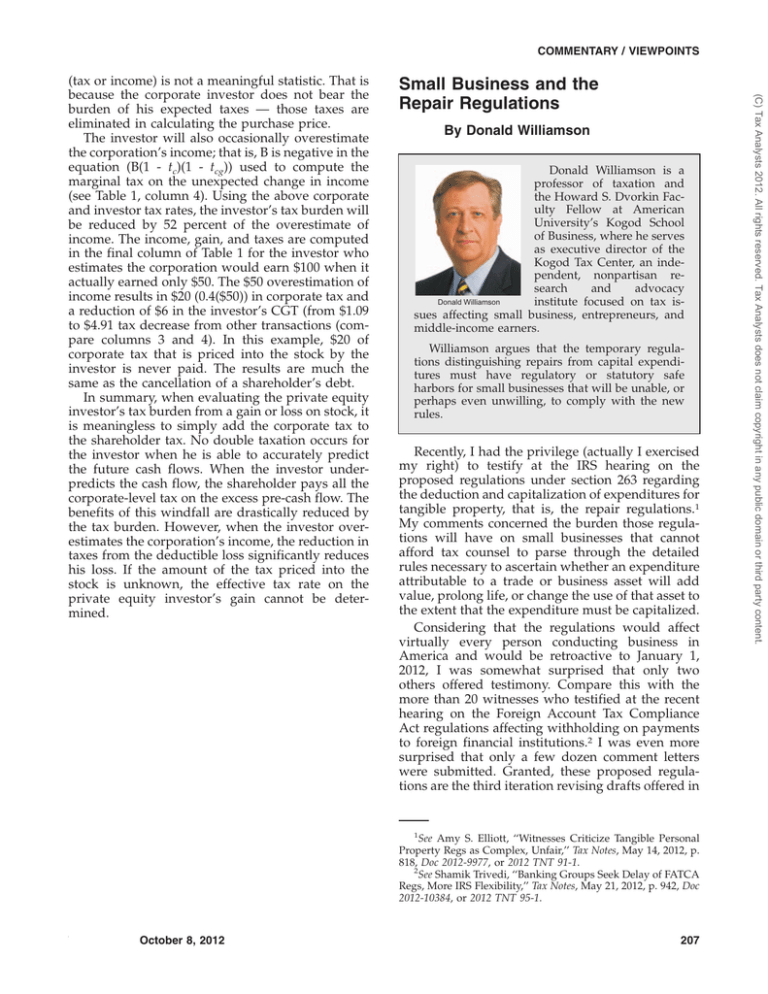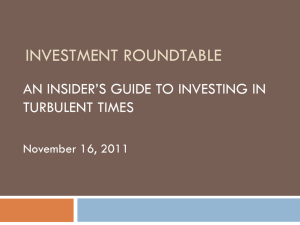
COMMENTARY / VIEWPOINTS
Small Business and the
Repair Regulations
By Donald Williamson
Donald Williamson is a
professor of taxation and
the Howard S. Dvorkin Faculty Fellow at American
University’s Kogod School
of Business, where he serves
as executive director of the
Kogod Tax Center, an independent, nonpartisan research
and
advocacy
Donald Williamson
institute focused on tax issues affecting small business, entrepreneurs, and
middle-income earners.
Williamson argues that the temporary regulations distinguishing repairs from capital expenditures must have regulatory or statutory safe
harbors for small businesses that will be unable, or
perhaps even unwilling, to comply with the new
rules.
Recently, I had the privilege (actually I exercised
my right) to testify at the IRS hearing on the
proposed regulations under section 263 regarding
the deduction and capitalization of expenditures for
tangible property, that is, the repair regulations.1
My comments concerned the burden those regulations will have on small businesses that cannot
afford tax counsel to parse through the detailed
rules necessary to ascertain whether an expenditure
attributable to a trade or business asset will add
value, prolong life, or change the use of that asset to
the extent that the expenditure must be capitalized.
Considering that the regulations would affect
virtually every person conducting business in
America and would be retroactive to January 1,
2012, I was somewhat surprised that only two
others offered testimony. Compare this with the
more than 20 witnesses who testified at the recent
hearing on the Foreign Account Tax Compliance
Act regulations affecting withholding on payments
to foreign financial institutions.2 I was even more
surprised that only a few dozen comment letters
were submitted. Granted, these proposed regulations are the third iteration revising drafts offered in
1
See Amy S. Elliott, ‘‘Witnesses Criticize Tangible Personal
Property Regs as Complex, Unfair,’’ Tax Notes, May 14, 2012, p.
818, Doc 2012-9977, or 2012 TNT 91-1.
2
See Shamik Trivedi, ‘‘Banking Groups Seek Delay of FATCA
Regs, More IRS Flexibility,’’ Tax Notes, May 21, 2012, p. 942, Doc
2012-10384, or 2012 TNT 95-1.
TAX NOTES, October 8, 2012
207
(C) Tax Analysts 2012. All rights reserved. Tax Analysts does not claim copyright in any public domain or third party content.
(tax or income) is not a meaningful statistic. That is
because the corporate investor does not bear the
burden of his expected taxes — those taxes are
eliminated in calculating the purchase price.
The investor will also occasionally overestimate
the corporation’s income; that is, B is negative in the
equation (B(1 - tc)(1 - tcg)) used to compute the
marginal tax on the unexpected change in income
(see Table 1, column 4). Using the above corporate
and investor tax rates, the investor’s tax burden will
be reduced by 52 percent of the overestimate of
income. The income, gain, and taxes are computed
in the final column of Table 1 for the investor who
estimates the corporation would earn $100 when it
actually earned only $50. The $50 overestimation of
income results in $20 (0.4($50)) in corporate tax and
a reduction of $6 in the investor’s CGT (from $1.09
to $4.91 tax decrease from other transactions (compare columns 3 and 4). In this example, $20 of
corporate tax that is priced into the stock by the
investor is never paid. The results are much the
same as the cancellation of a shareholder’s debt.
In summary, when evaluating the private equity
investor’s tax burden from a gain or loss on stock, it
is meaningless to simply add the corporate tax to
the shareholder tax. No double taxation occurs for
the investor when he is able to accurately predict
the future cash flows. When the investor underpredicts the cash flow, the shareholder pays all the
corporate-level tax on the excess pre-cash flow. The
benefits of this windfall are drastically reduced by
the tax burden. However, when the investor overestimates the corporation’s income, the reduction in
taxes from the deductible loss significantly reduces
his loss. If the amount of the tax priced into the
stock is unknown, the effective tax rate on the
private equity investor’s gain cannot be determined.
COMMENTARY / VIEWPOINTS
Suggested Safe Harbors
Clearly, for small businesses, which comprise
much of the economic productivity in our country,
some relief is in order. Several safe harbors should
be created or expanded in the regulations to ease
the compliance burden on small business. For example, the de minimis rule in prop. reg. section
1.263(a)-2T(g) that provides a limited exemption
from capitalization for some amounts paid to acquire or produce a unit of property requires a
‘‘certified audited financial statement that is accompanied by a report of an independent CPA.’’ Few
small businesses need those generally accepted
accounting principles conforming statements, and
most rely instead on statements of cash flow to
measure their success. Certainly, for small businesses, a compliance review or even a compilation
statement prepared by a CPA should satisfy the
intent of the regulations to secure an opinion of an
independent professional regarding the treatment
208
of items that are expensed or capitalized. Regardless of what constitutes an ‘‘applicable financial
statement,’’ further adjustment to the safe harbor is
needed to increase the aggregate exemption from
capitalization above the current limit of 0.1 percent
of the taxpayer’s gross receipts or 2 percent of the
taxpayer’s total depreciation for the tax year, limits
so small they will be meaningless to nearly all small
businesses in the country.
Also, a second de minimis safe harbor is needed
in prop. reg. section 1.263(a)-3T(e)(2)(ii) for determining when a building must be broken into its
structural components to measure whether an expenditure constitutes an improvement to the building that requires capitalization. Requiring a small
business that owns a building with an adjusted
basis of less than $1 million to identify and separately account for the building’s HVAC, plumbing,
electrical, fire protection, gas distribution, and security systems as well as any elevators, escalators, or
other structural components as the IRS may prescribe is unnecessary and unduly burdensome.
Clearly, some dollar threshold for triggering these
rules is in order.
And, taxpayers with average gross receipts no
greater than $10 million for the three prior years
should be exempt from the repair regulations. That
safe harbor would not undermine the regulations’
impact on businesses that have the resources, expenditures, and desire to alter their accounting
methods to avoid tax. Section 263A(b)(2)(B) already
includes a $10 million threshold for exemption from
the capitalization principles of direct and indirect
costs associated with the taxpayer’s inventory and
production of other real or personal property for
resale. Providing a similar exemption in the repair
regulations would offer the relief from burdensome
compliance that small businesses need.
More Fundamental Revisions
Aside from these suggestions for revising the
repair regulations, it may be time to consider more
fundamental changes to the code itself regarding
administrative rulemaking. For example, the proposed Executive in Need of Scrutiny (REINS) Act
(H.R. 3765), introduced by former congressman
Geoff Davis, who served on the Ways and Means
Committee, would compel Congress to approve
any regulation with an economic impact of $100
million or more. All tax practitioners can think of
provisions in the code other than section 263 (for
example, sections 482 and 1502) to which this
proposal would apply.
Although section 7805(f) provides some protection from overly complex proposed or temporary
regulations, such as the repair regulations, by requiring that the regulations be submitted for comment to the chief counsel for advocacy of the Small
TAX NOTES, October 8, 2012
(C) Tax Analysts 2012. All rights reserved. Tax Analysts does not claim copyright in any public domain or third party content.
2006 and 2008, so perhaps those who wanted to
weigh in on them had already done so. Despite the
importance and magnitude of the project, I was left
with the impression that no one outside the business community subject to the jurisdiction of the
IRS Large Business and International Division is
aware of these far-reaching proposals.
And, I fear, I’m being proven right. In an informal survey of the leadership of several professional
organizations representing preparers of small business tax returns across the United States, most were
completely unaware of the regulations, and those
who were aware of them knew little of their content. As director of the graduate tax program at
American University, I conducted an informal survey of our alumni, composed almost exclusively of
CPAs, and found that few had any notion of what
impact the repair regulations would have on their
businesses or the businesses of their clients. If
small-business tax practitioners and my former
graduate tax students are not keeping abreast of
these developments, I can safely assume there are
millions of taxpayers and their return preparers
who are equally oblivious to the impending burden.
Although I can condemn tax professionals for
their lack of knowledge about this most significant
development in the law, I empathize with average
business owners who think about their income tax
returns only shortly before they are due, relying on
others to deal with the compliance problems these
new rules present. Although the ‘‘Big 4’’ and other
large accounting firms are expecting an enormous
influx of business from the thousands of Forms
3115, ‘‘Application for Change in Accounting
Method,’’ it is unknown whether small businesses
will be able to get the help they need at a fee they
can afford.
COMMENTARY / VIEWPOINTS
Conclusion
With statutes such as the Dodd-Frank Act prescribing broad and vague rules that call for consumers to have access to consumer financial
products and services that are ‘‘fair, transparent,
and competitive,’’ and the massive healthcare leg-
3
2002-1 C.B. 815, Doc 2002-9029, 2002 TNT 72-6.
For further discussion and analysis of this proposal, see
David Kautter and Donald Williamson, ‘‘A Simplified Cash
Method of Accounting for Small Business,’’ Tax Notes, Feb. 13,
2012, p. 863, Doc 2012-1332, or 2012 TNT 32-7.
4
TAX NOTES, October 8, 2012
islation that no legislator has actually read, let alone
come to understand, the problem of regulations’
serving as substantive legislation transcends the
code’s frequent direction that the IRS draft regulations to carry out its rules. However, unlike healthcare or even the financial marketplace, the code
offers unique opportunities to carve out safe harbors and other exemptions from complex regulations and greatly benefits small business without
sacrificing federal policy goals.
Through targeted legislation or administrative
exemption, relief from burdensome regulations for
small business will actually improve compliance at
minimal cost to technical accuracy. Demanding that
small businesses adhere to lengthy, complicated
technical rules such as the repair regulations — no
matter how theoretically precise — will not yield
significant revenue and will only serve to increase
compliance costs, which will ultimately impede job
creation. This universal enforcement may well
backfire when small business owners discover that
the cost of being found noncompliant — additional
tax, interest, and penalties — is less than the time,
resources, and cost spent in efforts to comply. If,
during this election season, average taxpayers learn
of these regulations and what they require, the
regulations could well serve as a poster child for
political campaigns’ advocating curtailment of unnecessary government intrusions into the affairs of
small business.
Those drafting our laws and regulations must
understand that taxpayers will comply with rules
like the repair regulations as long as they believe it
is in their interest. But, when rules are incomprehensible, unworkable, impractical, or simply silly to
average citizens, those rules will be ignored. A good
first step is for the repair regulations to set out a
comprehensive set of safe harbors for small business.
209
(C) Tax Analysts 2012. All rights reserved. Tax Analysts does not claim copyright in any public domain or third party content.
Business Administration, the effect of these submissions is unknown. Perhaps those reviews have been
sufficient in the past, but this protection might not
be enough today in light of the complexity of
regulations that apply to small businesses. Therefore, some formal congressional review over legislative blank checks of authority to the IRS appears
in order, at least concerning a regulation’s impact
on small business.
Alternatively, liberalizing section 448’s safe harbor for the use of the cash method of accounting
would provide significant compliance relief for
small businesses. Ways and Means Committee
members Rick Berg, R-N.D., and Mike Thompson,
D-Calif., have introduced the Small Business Tax
Simplification Act (H.R. 4643), which would increase from $5 million to $10 million the maximum
gross receipts for calculating taxable income using
the cash method rather than the accrual method.
This expansion of the section 448 election —
coupled with current administrative exemptions
such as Rev. Proc. 2002-283 for expensing otherwise
inventoriable items — will effectively release 98
percent of all businesses in America from burdensome accounting rules, including many of the requirements of the repair regulations.4





